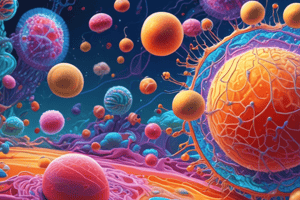Podcast
Questions and Answers
What is the function of the endoplasmic reticulum in a cell?
What is the function of the endoplasmic reticulum in a cell?
- Energy production
- Transporting substances throughout the cell (correct)
- Digesting food and cell debris
- Packaging and distributing substances
Why does the rough endoplasmic reticulum appear bumpy?
Why does the rough endoplasmic reticulum appear bumpy?
- It is filled with genetic material
- It is the site of energy production
- It contains lysosomes
- It is covered with ribosomes (correct)
Where are chromosomes found in a cell?
Where are chromosomes found in a cell?
- Endoplasmic reticulum
- Ribosomes
- Nucleus (correct)
- Mitochondria
Which organelle is known as the powerhouse of the cell?
Which organelle is known as the powerhouse of the cell?
What is the function of lysosomes in a cell?
What is the function of lysosomes in a cell?
Why are lysosomes called 'suicide sacs'?
Why are lysosomes called 'suicide sacs'?
Which organelle is responsible for packaging and distributing substances in the cell?
Which organelle is responsible for packaging and distributing substances in the cell?
Where is ATP produced in a cell?
Where is ATP produced in a cell?
What is the function of the cell membrane in a cell?
What is the function of the cell membrane in a cell?
Why are organelles often referred to as the 'little organs' of the cell?
Why are organelles often referred to as the 'little organs' of the cell?
Which organelle is considered the control center or brain of the cell?
Which organelle is considered the control center or brain of the cell?
Where are most cellular activities taking place within a cell?
Where are most cellular activities taking place within a cell?
What is the primary function of the nucleus in a cell?
What is the primary function of the nucleus in a cell?
What do organelles of a cell have in common with organs in the human body?
What do organelles of a cell have in common with organs in the human body?
What distinguishes organelles from each other within a cell?
What distinguishes organelles from each other within a cell?
Flashcards are hidden until you start studying
Study Notes
Cellular Organelles and Their Functions
- The endoplasmic reticulum (ER) is a type of organelle responsible for synthesizing proteins and lipids, and transporting them to other parts of the cell.
Endoplasmic Reticulum
- The rough endoplasmic reticulum appears bumpy due to the presence of ribosomes attached to its surface.
Chromosomes
- Chromosomes are found in the nucleus of a cell.
Mitochondria
- Mitochondria are known as the powerhouse of the cell, responsible for generating most of the cell's energy in the form of ATP (adenosine triphosphate).
Lysosomes
- Lysosomes are membrane-bound organelles that contain digestive enzymes and are responsible for breaking down and recycling cellular waste and foreign substances.
- Lysosomes are called 'suicide sacs' because they can self-destruct by releasing their digestive enzymes to break down the cell's own components if needed.
Golgi Apparatus
- The Golgi apparatus is an organelle responsible for packaging and distributing substances within the cell.
ATP Production
- ATP is produced in the mitochondria of a cell.
Cell Membrane
- The cell membrane, also known as the plasma membrane, is a thin layer of lipid and protein molecules that surrounds the cell and regulates the movement of materials in and out of the cell.
Organelles
- Organelles are often referred to as the 'little organs' of the cell because they perform specific functions, similar to how organs perform specific functions in the human body.
- The nucleus is considered the control center or brain of the cell, where most cellular activities take place.
- The primary function of the nucleus is to store and protect the cell's genetic material, DNA.
Nucleus
- The nucleus is the control center of the cell, where most cellular activities take place.
Comparison to Human Body Organs
- Organelles of a cell have in common with organs in the human body that they perform specific functions necessary for the survival of the cell or organism.
Distinctive Features of Organelles
- What distinguishes organelles from each other within a cell is their unique structure and function.
Studying That Suits You
Use AI to generate personalized quizzes and flashcards to suit your learning preferences.




